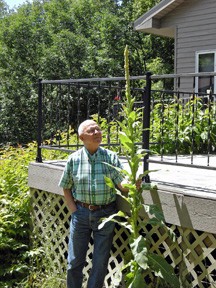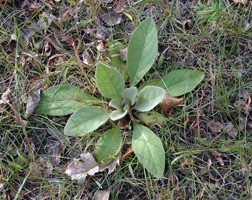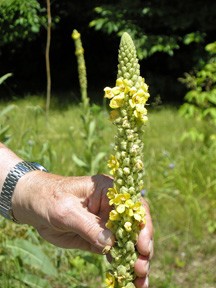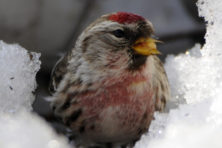Common Mullein
- Share
- Tweet
- Pin
- Share
Many years ago Charlotte and I invited our friends Merlin and Carol Lang to have dinner with us on New Year’s Eve. Merlin was manager of Newport State Park at the time. When we greeted them at the door Merl handed me a good luck walking stick nicely varnished and decorated with a white silk bow. I was quite amazed at how light and strong it was. Our guests challenged us to guess from which wild plant the sturdy cane was made. What a neat way to end the year!

This Mullein is more than 7-feet-tall and should reach 8 or 9 feet when finished growing.
It soon became apparent that the somewhat spherical knob-like handle had been part of the plant’s root. We could see tiny holes in it where the smaller fibrous rootlets had been trimmed away. The handsome rod reminded me of a combination of bamboo and corn stalk. Simply put, we were stumped, then pleasantly surprised to learn that he had fashioned it from what is perhaps the world’s easiest weed to identify, the Mullein!
We were pleased two summers following that memorable New Year’s Eve get-together to find a first-year Mullein plant growing at the south edge of the front yard at The Ridges Sanctuary upper range light residence, where we were living at the time. The large rosette of soft, wooly, light gray-green leaves insured us that we could enjoy the beauty of the mature plant the following year. Mulleins are biennial sun-loving plants requiring two years to develop a stalk, which will produce beautiful yellow flowers followed by many seeds.
That plant grew surprisingly well all the second summer until by late August it had reached the unusually great height of 9 feet 8 inches. I took great pleasure in starting my daily hikes with visitors by leading them down the front walk of the range light residence to show them the giant weed. Finally one of the guests, in a politely accusing tone, said, “You surely must fertilize that plant.” I laughed out loud at the accuracy of her allegation. In fact, in all honesty, it was being fertilized in part by my own fertilizer. You see, it was growing directly above the drain field of our septic tank!

Here is a first-year Mullein plant.
Today we have a number of second-year Mulleins doing nicely on our east bank close to the house. I built a new stairway up that bank a few years ago and disturbed the ground quite severely. My guess is that when several truckloads of glacial till were brought in as “fill” after our house had been built 31 years ago, many Mullein seeds were unintentionally included, and being able to remain dormant upwards of a hundred years, they will still be perfectly viable. Disturb the soil a little and that’s all they need for germination.
The tallest of the plants grows right next to our deck at a point where we look out our east kitchen window above the sink and can watch the tallest plant’s progress from day to day. Today it is approaching 7 feet. No, I am not fertilizing this beauty!
As kids we called the plant Indian tobacco, but I swear we never tried smoking it – at least not that plant. In later years I heard it referred to as Silver Mullein and have occasionally used this title. Pour some water onto the leaves and I’m sure you will see why this name came about. What a host of colloquial designations this fascinating plant has including great and common Mullein, velvet plant, candlewick (its hairs were used by peasants to make candlewicks), flannel-leaf, Aaron’s rod, Adam’s flannel, feltwort, Bullock’s lungwort, velvet dock, shepherd’s club, torchwort, hedge taper, and blanket leaf. One of our friends calls it “the saguaro of the north.”
One story I came upon centers around young girls of a certain religious faith who were forbidden to use any cosmetics. Eventually they learned that vigorously rubbing a piece of Mullein leaf over their cheeks gently irritated the skin producing a nice rosy glow, as though they indeed had used some fancy manufactured rouge.

Only a small number of flowers will open at the same time.
First year plants, reproduced only from seeds, send out a stout tap root having many smaller lateral roots. The thick, velvety hairs covering the leaves will protect them from the extreme dryness and cold of the winter as well as from the intense heat and droughts of summer. A course, rough, hairy flower stalk will develop during the second summer. Often a few upright side “branches” will be produced, bringing about our friend’s nickname of “saguaro.” Large, showy, inch-wide, light yellow flowers, usually only a small number at a time, will adorn the thick-set spikes.
Each seed capsule from a single blossom contains many small brown seeds about 1/32 of an inch in diameter. Upwards of 100,000 seeds may be produced by one large plant. Little wonder that these eye-catching plants are so successful. Goldfinches and other wintering birds eat the seeds and very likely scatter some of them in their droppings.
Leaves at the base of the stalk may eventually reach 18 inches or even longer and do resemble tobacco. The plant’s upper leaves are considerably smaller and more pointed. The bases extend down the stem to the next lower leaves. What beautiful “engineering” the placement and shape of the leaves on the stem have in funneling rainwater downward and close to the base of the stalk, below which are growing the roots. Even the velvety waterproof nature of the leaves helps the water drain quickly downward.

The open flowers and overall wooliness of the plant are quite fascinating, as is this visiting quarter-inch-long weevil at the top of the right blossom.
We thoroughly admire these majestic yellow-flowered weeds and can even visualize the potential beauty of a first-year rosette, potted and taken indoors for winter enjoyment. Other plant fanciers may use the rosettes of the large gray-green leaves in fall as the base for decorative arrangements.
Call it what you wish, Common Mullein, wild tobacco or velvet plant. Whatever tickles your fancy, these imposing widespread plants will decorate the American landscape for centuries to come. For the beginner it is a perfect weed to serve as a starting point for an enjoyable study of easy-to-find and recognizable plants. Without a doubt it is the simplest weed in the world to identify as well as one of the most beautiful.

